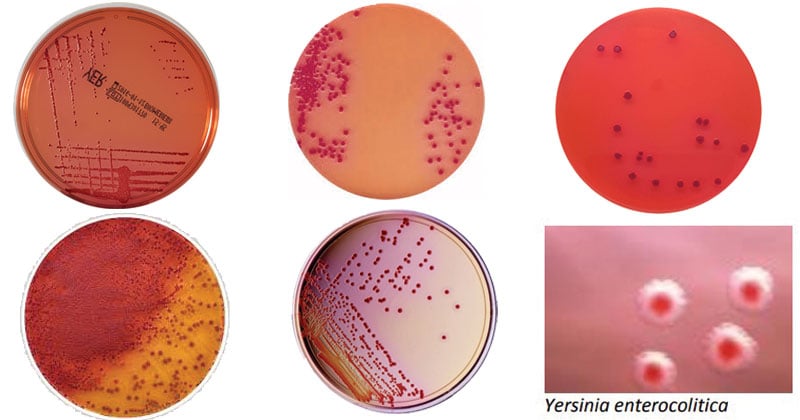- Yersinia Selective Agar was first described by Schiemann as an alternative to MacConkey Agar and other commonly used media for isolation of Yersinia enterocolitica, a causative agent of gastroenteritis.
- Yersinia enterocolitica is a significant food or waterborne enteric pathogen being reported to have caused epizootic outbreaks of diarrhea, lymphadenopathy, pneumonia and spontaneous abortions in various animals.
- Yersinia Selective Agar is a selective and differential medium supporting good growth of Y. enterocolitica and some Yersinia spp.

Image Source: Biomerieux, Thermo Fisher Scientific, Carl Roth, Southern Group Laboratory, Toliopoulos Diagnostics, Merck.
Interesting Science Videos
Composition of Yersinia Selective Agar
| Ingredients | Gms/liter |
| Peptone, special | 20.000 |
| Yeast extract | 2.000 |
| Mannitol | 20.000 |
| Sodium pyruvate | 2.000 |
| Sodium chloride | 1.000 |
| Magnesium sulfate | 0.010 |
| Sodium deoxycholate | 0.500 |
| Neutral red | 0.030 |
| Crystal violet | 0.001 |
| Agar | 12.500 |
Final pH (at 25°C): 7.4±0.2
Note: Yersinia Selective Agar is used with cefsulodin and novobiocin for the isolation of Yersinia enterocolitica in a laboratory setting.
Principle of Yersinia Selective Agar
- The medium differentiates between mannitol fermenting and non-fermenting bacteria.
- Microorganisms that ferment the sugar mannitol acidify the medium and cause a localized drop in pH around the colonies.
- In the presence of neutral red, the colonies take red color. Due to the localized pH decrease, a zone of precipitated bile may also be present.
- Mannitol negative organisms form colorless and translucent colonies.
- The medium is selective due to the presence of sodium deoxycholate and crystal violet, which inhibit gram-positive and a number of gram-negative bacteria.
- Addition of antibiotic supplement makes it highly selective for Yersinia.
- Typical colonies of Y. enterocolitica will form dark red colonies resembling bulls-eye, which are normally surrounded by a transparent border.
- Colony size, smoothness and ratio of the border to center diameter may vary among different serotypes.
- Sodium Chloride maintains the osmotic balance of the medium. Sodium Pyruvate and Magnesium Sulfate stimulate organism growth. Agar is the solidifying agent.
Preparation and Method of Use of Yersinia Selective Agar
- Suspend 29.02 grams in 500 ml distilled water.
- Heat to boiling to dissolve the medium completely.
- Sterilize by autoclaving at 15 lbs pressure (121°C) for 15 minutes.
- Cool to 45-50°C and aseptically add reconstituted contents of 1 vial of Yersinia Selective Supplement or aseptically add 10 mL of a sterilized aqueous solution containing 4 mg of Cefsulodin and 2.5 mg of Novobiocin.
- Mix well before pouring into sterile Petri plates.
- Streak the specimen as soon as possible after it is received in the laboratory. The streak plate is used primarily to isolate pure cultures from specimens containing mixed flora.
- Alternatively, if the material is being cultured directly from a swab, roll the swab over a small area of the surface at the edge; then streak from this inoculated area.
- Incubate at 22-32°C for 24-48 hours or suspend the sample (food, feces, etc.) in sterile Phosphate Buffer Saline and incubate for up to 21 days (4) at 4°C.
- Periodically subculture samples onto Yersinia Agar Plate and incubate as above.
Result Interpretation on Yersinia Selective Agar
Yersinia enterocolitica colonies appear translucent or translucent with dark pink centers. Colony edges are entire or irregular. After 48 hour incubation, colonies appear dark pink with a translucent border and may be surrounded by a zone of precipitated bile. Growth of non-Yersinia organisms is marked to completely inhibited.
| Organisms | Growth |
| Yersinia enterocolitica | Translucent with dark pink center & bile precipitate (bulls-eye colonies) |
| Yersinia pseudotuberculosis | Growth with dark pink center & bile precipitate. No transparent zone around the colonies. |
Uses of Yersinia Selective Agar
- It is recommended for the selective isolation and enumeration of Yersinia enterocolitica from clinical specimens and food samples.
- Yersinia Selective Agar may also be used for the isolation of Yersinia species other than Y. enterocolitica, e.g., for Y. pseudotuberculosis.
Limitations of Yersinia Selective Agar
- Serratia liquefaciens, Citrobacter freundi and Enterobacter agglomerans may resemble Y. enterocolitica that can be further identified by biochemical tests.
- A less selective medium, such as MacConkey Agar, should also be inoculated with the specimen (and incubated at 35 +/- 2° C) for the detection of other pathogens involved in the infection.
- A “cold enrichment” procedure may occasionally be necessary for the isolation of Yersinia enterocolitica, from stool specimens and other materials such as food.
- Biochemical and serological confirmation is necessary for complete identification of suspicious isolates.
- Yersinia Selective Agar is not intended for use in the diagnosis of a disease or other conditions in humans.
- Due to nutritional variation, some strains may be encountered that grow poorly or fail to grow on this medium. Further tests are necessary for confirmation of Yersinia spp.
- Growth of Yersinia frederiksenii, Y. kristensenii, Y. pseudotuberculosis and Y. intermedia is not inhibited on complete medium. Colonies of these organisms must be differentiated from Y. enterocolitica on the basis of additional characteristics.
References
- http://himedialabs.com/TD/M843.pdf
- https://www.bd.com/resource.aspx?IDX=8992
- http://www.oxoid.com/UK/blue/prod_detail/prod_detail.asp?pr=CM0653&cat=&c=UK&lang=EN
- https://foodsafety.neogen.com/en/yersinia-selective-agar
- https://foodsafety.neogen.com/pdf/acumedia_pi/7257_pi.pdf
- http://www.oxoid.com/UK/blue/prod_detail/prod_detail.asp?pr=CM0653&cat=&c=UK&lang=EN
